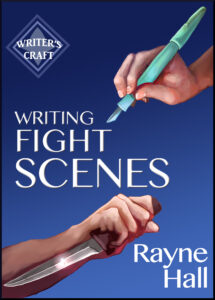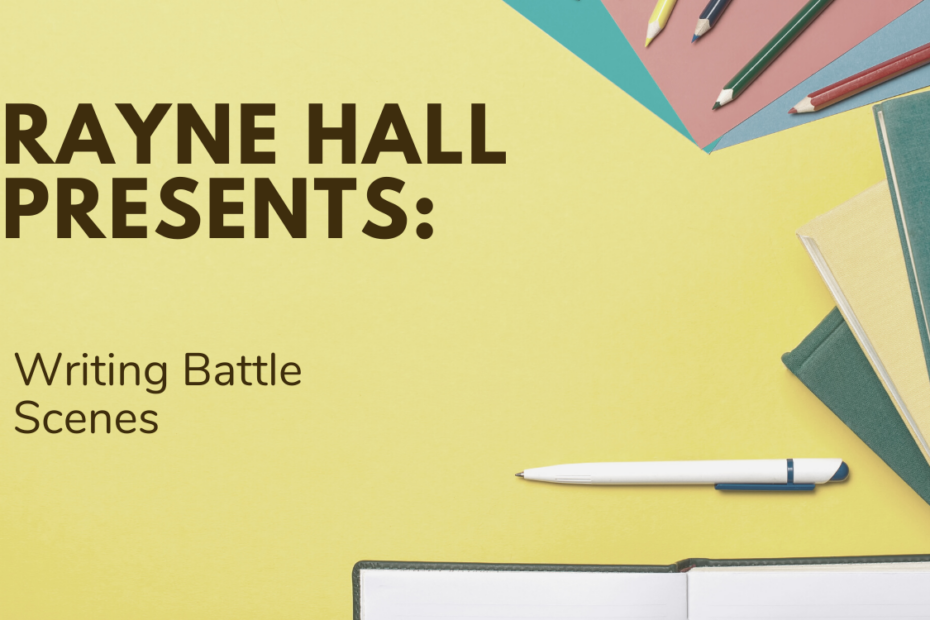She’s back! Rayne Hall returns with a battle plan for tackling battle scenes.
When the plot calls for a battle – for example, in a historical romance novel – many writers are at a loss how to craft this scene.
Some skip the challenge altogether, flash forward to the next scene, and deprive the readers of the experience. (When Konrad returned with his victorious army…) However, disappointing your readers is not a good option.
Others authors grit their teeth and pen the scene, but find it a struggle, and their beta readers and editors tell them that this part does not match the quality of the rest of the book.
Common Mistakes
Here are five common blunders writers make with battle scenes.
– Battles break out spontaneously without planning or preparation by anyone.
– Archers shoot arrows after the close-up fighting has started. If they did this in reality, they would kill as many of their own men as enemy soldiers.
– The soldier character observes what his mates are doing at the other side of the battlefield and how the sun sets on the horizon, as if the immediate danger didn’t require all his attention. If he did this in reality, he’d be dead in a second.
– The soldier thinks about life, death, politics or anything else while he is fighting. This is not plausible, because if he took his attention off the immediate fighting for even a moment, he’d be dead.
– The soldier is aware of the overall development of the battle while he’s involved in the fighting, as if he had a means to know.
Let’s look at how you can avoid these blunders and write a plausible, exciting battle scene.
Your Battle Scene Strategy
- Choose your point-of-view carefully, and stick with it. The individual fighter has to be totally focused on the action affecting him. This is a very limited view. He can’t see what goes on a few feet from him, let alone what’s happening at the other end of the battlefield or how the sun dyes the horizon bloody red. Resist the temptation to provide ‘big picture’ view while the fighting is on.
- Provide the reader with ‘big picture’ information before and after the battle. Before the battle begins, you can show the terrain, the size of the enemy army, and other aspects you want the reader to know. When the battle is over, the reader can see the outcome: which side won, how many have fallen, who has survived.
- Stack the odds against your heroes. The readers’ natural sympathies lie with the smaller army. The greater you can make the numerical difference, the better. The evil overlord’s army is bigger than the hero’s, and it is much better equipped, too.
- Battles don’t just happen: they are planned. At least one side seeks the battle and is prepared. While there have been occasions in history when enemy units bumped into each other by accident and started fighting, this is not the norm, and unless you’re very knowledgeable about military matters, it won’t come across as plausible.
- The generals plan a battle strategy in advance, and make sure that their officers know it. In the heat of the battle, it’s often impossible to change strategy or give orders. Sometimes, soldiers are still fighting when the battle has already been decided, because they don’t know that their king is dead or the enemy general has surrendered.
- Often, the location decides the outcome of the battle. Generals choose the location carefully – and so should you, the author!
If the battle takes place on a slope, the army uphill has a huge advantage, because it’s easier to fight downhill than uphill, and because missiles fly further.
Each general tries to make the battle happen in terrain which favours his own army, and where the enemy can’t fully deploy his. For example, chariots are fearsome on the plain, but useless in the mountains. Foot archers can fight on any terrain, especially in the mountains. The general who has many chariots will try to force a battle on the plain, while the general who has archers will try to lure his enemy into mountainous terrain.
If one general has a small army and his enemy has a large one, he’ll try to lure them into a gorge or other restricted space where they can’t move.
- Armies are organised in units either by level of skill and experience (elite, veterans, novices, untrained peasants…) or by weapons and equipment (cavalry, infantry, archers, spearmen, chariots…) or both. To which unit does your PoV character belong?
- Before the battle, the general probably addresses the troops, firing their fighting spirit and courage.
This pep talk may include depersonalising the enemy, because soldiers are more willing to kill monsters than to kill fellow human beings. It’s easy to kill a man whom you consider a menace to your children, and difficult to kill him if you think of him as a fellow human who loves his children as much as you love yours.
- While the fight is on, the PoV character is totally focused on two things: to survive and to kill. He won’t see anything or anyone other than the enemy soldier opposite him.
- The PoV may get injured, and depending on the nature of the wound, he may fight on. If he stops, he’ll get killed. The real pain may not kick in until after the fight when the adrenaline wears off.
- Noble emotions and ideals have no room during battle. The thinker of noble thoughts and carrier of high ideals during battle won’t survive. If you want to show your hero’s nobility, do it when the fighting is over, for example, in the treatment of surviving enemies.
- Consider using interesting or extreme weather to make your battle scene unusual. Imagine pristine snow which gets trampled, becomes slippery, and stains red with blood. Or a strong wind which blows arrows off course. Or blistering heat and glaring sun. Or week-long rain turning the field into knee-deep mud, making it difficult for foot soldiers, let alone horses or chariots. Or fog blocking the view of the enemy.
How To Structure A Battle Scene
Part 1: Suspense
Describe the terrain, convey the battle strategy, show the preparations. The general gives a pep talk, the soldiers ready their weapons, say their prayers, get into position.
Part 2: Start
Both armies shoot missiles (bullets, cannon balls, stones or arrows) to take out as many of the enemy as possible before they get close. In a historical novel, clouds of arrows may darken the sky before the battle begins.
Part 3: Action
The PoV fights. Everything happens very fast, so use fast-pace techniques, such as short sentences, short words, lots of verbs, few adjectives, no adverbs. Keep to the PoV’s narrow range of awareness.
Part 4 (optional): Surprise
Something unexpected happens and changes the course of the battle. Perhaps a relief force arrives to support one army, or a sudden downpour turns the ground into mud. Use this optional part only if your battle scene is long and detailed.
Part 5: Climax
This is the most exciting section of the fight scene. Make it fast-paced, breathless, dangerous. The challenge for the writer lies in shaping this part as the climax of the battle although the PoV character isn’t aware that it’s the climax. If possible, arrange it so your hero kills an important enemy personage, maybe their general, or their most fearsome warrior. This may not reflect the reality of most battles, but it pleases the readers.
Part 6: Aftermath
This section is also where you reveal the overall outcome of the battle. The PoV character and his comrades bandage their wounds and mourn their dead.
This is where you can inject realism if it suits your genre. Soon after the battle, there’ll be carrion birds (e.g. crows, vultures) feeding on the corpses. There’ll be humans (probably the victorious soldiers) gathering up reusable weapons (because weapons are valuable) and looting the corpses. The battlefield is covered in blood, gore, and amputated limbs. The stench is awful, because in death, the bladder and bowels have opened. Plus, there’s the smell from injuries, not just blood (which starts to stink only after a while) but the content of stomachs and intestines from belly wounds. The stench gets worse after a few hours, especially if the weather is hot. After some hours, the corpses will be crawling with flies, and before long, there’ll be maggots.
Obviously, in a romance novel you’ll want to tone down the gruesome bits, while in an action novel you may want to play them up.
Have you written a battle scene, or are you planning one for your novel? Tell us about it.
***

How To Write Exciting, Realistic Action Scenes
Do you struggle with fight scenes? Has your editor told you the novel is brilliant – except for this part?WritingFightScenes RayneHall Cover 2014-01-07
Learn step-by-step how to create fictional fights that leave the reader breathless with excitement.
The book gives you:
* A six-part structure to use as blueprint for your scene.
* Tricks how to combine fighting with dialogue
* Information about swords, daggers and other weapons, and suggestions how to write about them
It helps you to decide:
* What’s the best weapon for your character
* Where the scene takes place
* Which senses to use, how and when
* How much violence your fight needs
It shows you, step by step:
* How to write battles, riots, brawls and duels
* How our character can get out of trouble with self-defence techniques
* How to make the reader root for your hero
* Techniques for creating a sense of realism
* How to adapt your writing style to the fast pace of the action
* How to stir the readers’ emotion
Are you writing a thriller, a murder mystery, an action-adventure tale, historical fiction, a fantasy novel or a paranormal romance? Whatever your genre, this guide has professional techniques you can use. For the specific requirements of your story, there are sections on
* Fighting animals, including seres WritingFightScenes RayneHall SuluCat
* How magicians fight with magical weapons
* Male and female warriors
* Costuming and armour
* Siege warfare
* Naval battles and how pirates capture ships
* How to build erotic tension in a fight scenes
and much more!
If you’re a veteran warrior, this book shows how to turn your experience and skills into compelling prose. If you’ve never held a weapon and are clueless about fights, this book guides you step-by-step to create a plausible fight scene and avoid embarrassing blunders.
***
Rayne Hall has published more than fifty books in several languages under several pen names with several publishers in several genres, mostly fantasy, horror and non-fiction. She is the author of the bestselling Writer’s Craft series (Writing Fight Scenes, Writing Scary Scenes, Writing About Villains, Writing About Magic and more) and editor of the Ten Tales short story anthologies.
She is a trained publishing manager, holds a masters degree in Creative Writing, and has worked in the publishing industry for over thirty years.
Having lived in Germany, China, Mongolia and Nepal, she has now settled in a small dilapidated town of former Victorian on the south coast of England where she enjoys reading, gardening and long walks along the seashore. She shares her home with a black cat adopted from the cat shelter. Sulu likes to lie on the desk and snuggle into Rayne’s arms when she’s writing.
To learn more about Rayne, visit her website or follow her on Twitter where she posts advice for writers, funny cartoons and cute pictures of her cat.
